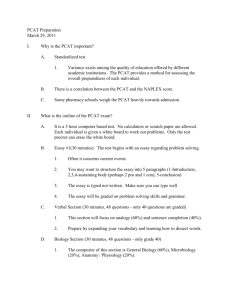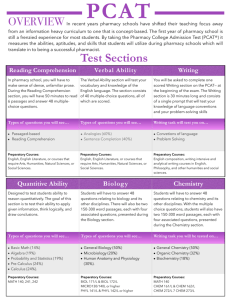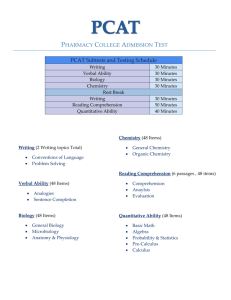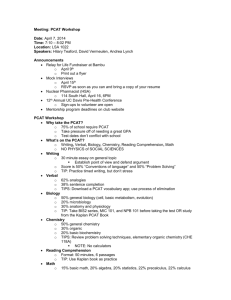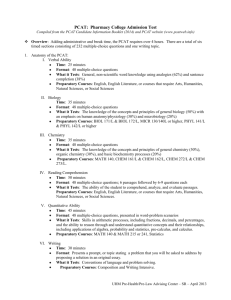View PDF
advertisement
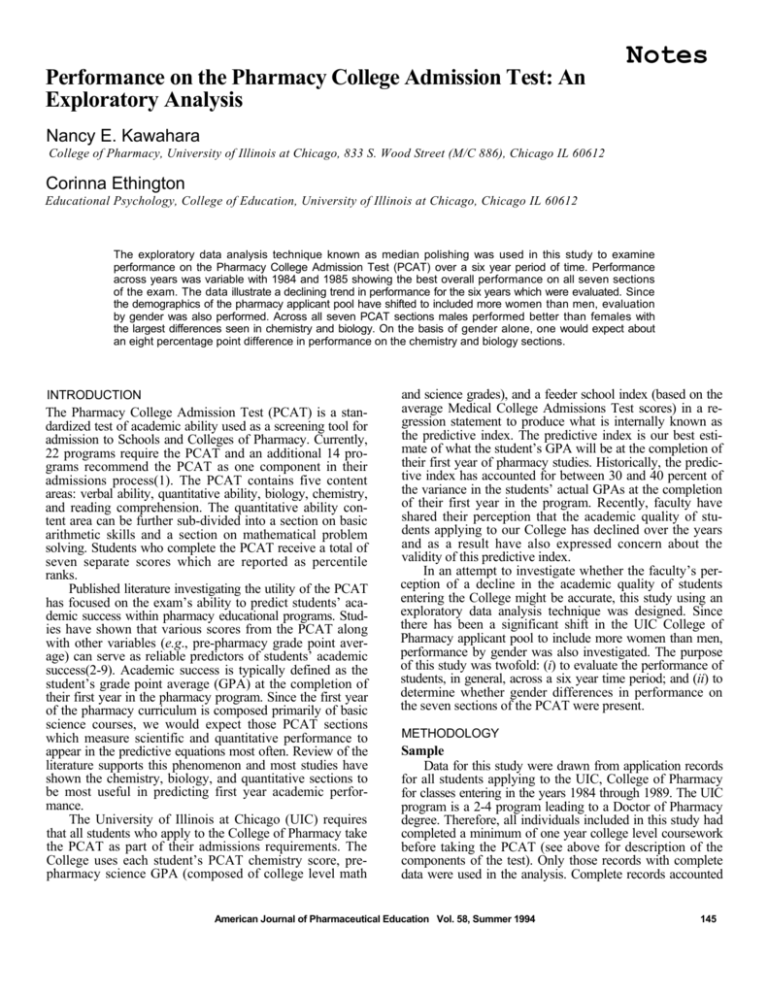
Performance on the Pharmacy College Admission Test: An Exploratory Analysis Notes Nancy E. Kawahara College of Pharmacy, University of Illinois at Chicago, 833 S. Wood Street (M/C 886), Chicago IL 60612 Corinna Ethington Educational Psychology, College of Education, University of Illinois at Chicago, Chicago IL 60612 The exploratory data analysis technique known as median polishing was used in this study to examine performance on the Pharmacy College Admission Test (PCAT) over a six year period of time. Performance across years was variable with 1984 and 1985 showing the best overall performance on all seven sections of the exam. The data illustrate a declining trend in performance for the six years which were evaluated. Since the demographics of the pharmacy applicant pool have shifted to included more women than men, evaluation by gender was also performed. Across all seven PCAT sections males performed better than females with the largest differences seen in chemistry and biology. On the basis of gender alone, one would expect about an eight percentage point difference in performance on the chemistry and biology sections. INTRODUCTION The Pharmacy College Admission Test (PCAT) is a standardized test of academic ability used as a screening tool for admission to Schools and Colleges of Pharmacy. Currently, 22 programs require the PCAT and an additional 14 programs recommend the PCAT as one component in their admissions process(1). The PCAT contains five content areas: verbal ability, quantitative ability, biology, chemistry, and reading comprehension. The quantitative ability content area can be further sub-divided into a section on basic arithmetic skills and a section on mathematical problem solving. Students who complete the PCAT receive a total of seven separate scores which are reported as percentile ranks. Published literature investigating the utility of the PCAT has focused on the exam’s ability to predict students’ academic success within pharmacy educational programs. Studies have shown that various scores from the PCAT along with other variables (e.g., pre-pharmacy grade point average) can serve as reliable predictors of students’ academic success(2-9). Academic success is typically defined as the student’s grade point average (GPA) at the completion of their first year in the pharmacy program. Since the first year of the pharmacy curriculum is composed primarily of basic science courses, we would expect those PCAT sections which measure scientific and quantitative performance to appear in the predictive equations most often. Review of the literature supports this phenomenon and most studies have shown the chemistry, biology, and quantitative sections to be most useful in predicting first year academic performance. The University of Illinois at Chicago (UIC) requires that all students who apply to the College of Pharmacy take the PCAT as part of their admissions requirements. The College uses each student’s PCAT chemistry score, prepharmacy science GPA (composed of college level math and science grades), and a feeder school index (based on the average Medical College Admissions Test scores) in a regression statement to produce what is internally known as the predictive index. The predictive index is our best estimate of what the student’s GPA will be at the completion of their first year of pharmacy studies. Historically, the predictive index has accounted for between 30 and 40 percent of the variance in the students’ actual GPAs at the completion of their first year in the program. Recently, faculty have shared their perception that the academic quality of students applying to our College has declined over the years and as a result have also expressed concern about the validity of this predictive index. In an attempt to investigate whether the faculty’s perception of a decline in the academic quality of students entering the College might be accurate, this study using an exploratory data analysis technique was designed. Since there has been a significant shift in the UIC College of Pharmacy applicant pool to include more women than men, performance by gender was also investigated. The purpose of this study was twofold: (i) to evaluate the performance of students, in general, across a six year time period; and (ii) to determine whether gender differences in performance on the seven sections of the PCAT were present. METHODOLOGY Sample Data for this study were drawn from application records for all students applying to the UIC, College of Pharmacy for classes entering in the years 1984 through 1989. The UIC program is a 2-4 program leading to a Doctor of Pharmacy degree. Therefore, all individuals included in this study had completed a minimum of one year college level coursework before taking the PCAT (see above for description of the components of the test). Only those records with complete data were used in the analysis. Complete records accounted American Journal of Pharmaceutical Education Vol. 58, Summer 1994 145 Table I. PCAT percentage score means by gender PCAT section 1984 1985 1986 Verbal Males Females Reading Comprehension Males Females Biology Males Females Chemistry Males Females Quantitative Males Females Arithmetic Males Females Math Males Females 1988 1989 44.73 42.54 44.50 44.90 39.07 34.57 34.40 35.37 38.94 35.09 35.91 32.17 51.96 42.82 49.10 50.18 46.51 40.29 41.29 45.48 45.28 41.67 43.04 39.48 62.33 54.72 61.67 53.40 58.56 45.08 53.14 45.71 59.04 46.13 50.39 46.42 59.50 48.57 58.75 50.15 52.27 44.13 50.37 44.84 48.82 41.44 45.51 43.42 45.25 40.60 52.41 45.86 35.84 38.14 41.41 38.52 38.80 36.35 39.61 34.85 43.29 39.94 52.28 44.97 33.59 38.83 42.59 37.26 37.49 34.52 38.98 35.95 49.50 44.10 54.75 49.72 41.61 41.32 44.93 43.71 44.89 42.93 44.81 38.88 Table II. Polished table for PCAT verbal through matha PCAT section 1984 1985 1986 Verbal Male Female Year effect Reading Comprehension Male Female Year effect Biology Male Female Year effect Chemistry Male Female Year effect Quantitative Male Female Year effect Arithmetic Male Female Year effect Math Male Female Year effect 1987 1987 1988 1989 Gender effect -0.59 0.59 6.52 -1.88 1.88 7.58 0.57 -0.57 -0.30 -2.17 2.17 -2.23 0.24 -0.24 -0.10 0.19 -0.19 -3.08 1.68 -1.68 Common effect 37.12 2.78 -2.78 3.95 -2.33 2.33 6.20 1.32 -1.32 -0.04 -3.89 3.89 -0.05 0.01 -0.01 0.04 -0.01 0.01 -2.18 1.79 -1.79 Common effect 43.44 -0.11 0.11 6.32 0.11 -0.11 5.43 2.82 -2.82 -0.38 -0.20 0.20 -2.78 2.53 -2.53 0.38 -1.93 1.93 -3.80 3.92 -3.92 Common effect 52.20 1.59 -1.59 6.13 0.42 -0.42 6.55 0.19 -0.19 0.30 -1.12 1.12 -0.30 -0.19 0.19 -2.77 -2.84 2.84 -3.44 3.88 -3.88 Common effect 47.90 0.44 -0.44 4.15 1.39 -1.39 10.37 -3.03 3.03 -1.78 -0.44 0.44 1.20 -0.66 0.66 -1.20 0.50 -0.50 -1.54 1.89 -1.89 Common effect 38.77 0.08 -0.08 2.92 2.06 -2.06 9.93 -4.22 4.22 -2.48 1.07 -1.07 1.23 -0.11 0.11 -2.69 -0.08 0.08 -1.23 1.60 -1.60 Common effect 38.70 0.95 -0.95 2.68 0.77 -0.77 8.12 -1.60 1.60 -2.65 -1.14 1.14 0.20 -0.77 0.77 -0.20 1.22 -1.22 -2.27 1.75 -1.75 Common effect 44.11 a All values reported as percentage points. for 99 percent of the total number of records available. The sample consisted of 408 men and 748 women. Analyses In order to look at the trend in performance over time 146 as well as whether sex-related difference in performance were present, an exploratory data analysis technique known as median polishing was employed(10, 11). This technique was chosen because unlike standard inferential statistical American Journal of Pharmaceutical Education Vol. 58, Summer 1994 Fig. 1. Plot of relative performance on the PCAT verbal and PCAT reading comprehension sections for 1984 through 1989. Fig. 2. Plot of relative performance on the PCAT biology and PCAT chemistry sections for 1984 through 1989. tests, such as analysis of variance(ANOVA), it does not require the formulation of an up-front hypothesis. This technique entails a decomposition of the data, resulting in patterns of effects which may not be apparent in the summary data. The technique- successively sweeps information from the original data into a common value, row effects, and column effects. The patterns which emerge from the summary data may then lead to formulation of hypotheses which can be tested using more rigorous statistical methodology, such as ANOVA. The approach taken here is similar to that of Wainer (10) in analyses of trends in Scholastic Aptitude Test (SAT) performance. The model used in this study is similar to the model of ANOVA but it uses medians as opposed to means to describe the common effects, row effects, and column effects. For the factors involved in this study the model is the following: X ij = C + G i + U j + eij where Xij is the mean PCAT score for gender i in the entering year j; C is the common effect (median across entering years); G; is the effect of gender i; U is the effect of the entering year j; and e- is a residual. The residual is an indication of how well the model describes the data. Whenever an individual row or column deviates from a pattern which is generally followed by the other rows and columns it will be evident in the residual pattern for that particular row or column (e.g., the residual will be large in absolute value). At the present time, there is no commercially available statistical package which contains the median polishing Fig. 3. Plot of relative performance on the PCAT quantitative, PCAT arithmetic, and PCAT math sections for 1984 through 1989. American Journal of Pharmaceutical Education Vol. 58, Summer 1994 147 Fig. 4. Plot of performance relative to model prediction for females on the PCAT verbal and PCAT reading comprehension sections across years 1984 through 1989. Fig. 5. Plot of performance relative to model prediction for females on the PC A T biology and PC A T chemistry sections across years 1984 through 1989. technique. Therefore, all analyses were done by hand and confirmed using a program written for a personal computer by a colleague of one of the authors. The reader is referred to references 10 and 11 for a detailed description of how to perform this technique. The analysis consisted of two components. The first component was to run the exploratory data analysis. Results of the analysis were examined for overall trends in performance and for differences in performance by gender. The second phase consisted of examining the application data base for other variables that may offer an explanation for gender differences in performance, if any, identified in the exploratory analysis. RESULTS Table I shows the percentage score means by gender on each PCAT section for the six years of the analysis. Table II shows the completed polished tables for each of the seven reported scores from the PCAT. The common effect can be interpreted as the typical score for this group of men and women, while the gender and year effects are incremental changes in performance as a result of membership in a particular category. The cell residuals indicate the portion of the score not explained by the common value, gender, and year of application. For example, the mean performance score on the PCAT verbal for men in the application year 1989 can be expressed as: 37.12 + 1.68 + (-3.08) + 0.19 = 35.91 where 37.12 represents the common value (typical score for 148 Fig. 6. Plot of performance relative to model prediction for females on the PC AT quantitative, PC AT arithmetic, and PC AT math sections across years 1984 through 1989. American Journal of Pharmaceutical Education Vol. 58, Summer 1994 Table III. Mean and standard deviationa for quantitative college level quarter hours in math and science completed by gender 1984 1985 1986 1987 1988 1989 Male 84.27 ± 43.45 83.49 ± 35.04 92.73 ± 36.35 82.08 ± 39.39 86.30 ± 62.93 84.65 ± 39.30 Female 76.17 ± 35.34 71.50 ± 27.92 76.26 ± 32.97 72.67 ± 24.92 79.84 ± 31.09 77.89 ± 67.28 a Large standard deviations attributable to variation in the number of college years completed (e.g., minimum 2 year pre-pharmacy requirement to completion of a baccalaureate or masters degree in a quantitative field). Table IV. Mean and standard deviation for pre-pharmacy science grade point average by gender 1984 1985 1986 1987 1988 1989 Male 3.96 ± 0.57 3.83 ± 0.55 3.79 ± 0.51 3.87 ± 0.63 3.88 ± 0.57 3.68 ± 0.74 Female 3.81 ± 0.62 3.82 ± 0.53 3.86 ± 0.57 3.81 ± 0.54 3.84 ± 0.60 3.79 ± 0.61 men and women in this group); 1.68 represents the incremental increase in performance attributed to being a male; -3.08 represents the incremental decrease in performance attributed to the application year 1989; and 0.19 is the residual (portion of the score not accounted for by the common value, gender, and application year). Figures 1-3 are plots of the year effects which illustrate the relative performance across the six year time period. Figures 4-6 are graphic representations of the model residuals for the females in this study. Graphs are grouped according to similarity of subject matter for ease of comparison. The residual graphic representations for males would be the mirror image of that illustrated for females. Table III shows by gender the breakdown for total number of quantitative college level quarter hours (includes science and math courses) completed for each of the six years. Table IV illustrates by gender the pre-pharmacy science GPA for each of the six years evaluated. DISCUSSION Effects attributable to year of application are in many cases quite large. On the basis of application year alone, we would expect a difference in performance as high as 12.62 percentage points (e.g., arithmetic score between years 1985 and 1988). For all seven sections of the PCAT this data shows a trend towards declining performance. Suggesting that, in general, the faculty perception that academic quality of students applying to the UIC program over the time period for this study appears to be accurate. The effects seen as a result of gender are small. The largest gender effects are present in the performance on the PCAT biology and PCAT chemistry sections. On the basis of gender alone, one would expect about an eight percentage point difference in both PCAT biology and chemistry scores, while the difference in scores for all other PCAT sections would be less than four percentage points. While the gender effects are relatively small, they consistently favor performance for males. On the basis of gender alone, we would expect males to perform better on all seven sections of the PCAT. Examination of the cell residuals suggests that for most PCAT sections there is no consistent pattern across time for either men or women. However, the residual plot for female performance on the chemistry section demonstrates that female performance improved relative to what the model would predict across the six-year study period (see Figure 5). While overall performance on the chemistry section for this group of applicants declined over the six year study period, female applicants, in general, improved their performance. Most residuals are comparatively small indicating that, in general, the model describes the mean scores fairly well. However, there are three instances where the residual exceeds the effect which can be attributed to both gender and year of application (reading comprehension 1987; arithmetic skills 1986; quantitative ability 1986). In each of these instances the residual is in favor of females. This indicates that female performance in these years is better than what we would have expected. The large residuals indicate that there are interactive effects between gender and year of application. The Psychological Corporation, administrators of the PCAT, suggest that the scores received for performance on the chemistry and biology sections are most sensitive to the amount of previous relevant coursework the student has completed(12). It is well documented in the educational literature that males, in general, perform higher than females on test of quantitative ability. A variety of explanations for these gender difference in performance have been studied(13). One such theory is the differential coursework hypothesis(14-16). This hypothesis proposes that these differences are a function of the variations in the number of mathematical and scientific courses each sex completes. Males typically take more elective math and science courses, whereas, females tend to complete only those courses necessary for graduation. In an attempt to determine whether this hypothesis may explain the gender effects in performance on the PCAT chemistry and PCAT biology sections, we examined the data base for an indicator of science focused coursework. Our data base contained a variable which consisted of the total number of quarter hours each applicant had completed in college level science and math courses. While this is not a precise indicator of exposure to chemistry and biology, it does provide information regarding the potential exposure each applicant may have received. For each year of this analysis men completed more science and math hours than women. This finding does not allow us to confirm that this difference in the number of science hours, as we defined it, is the cause of this gender- American Journal of Pharmaceutical Education Vol. 58, Summer 1994 149 related difference in performance, but it does suggest that the coursework hypothesis may contribute to this phenomenon. While males out perform females on standardized tests of quantitative ability, females obtain higher grades in quantitative courses than males(16). This creates a problematic relationship between the traditional granting of grades and the application of standardized tests to evaluate academic ability. Since the UIC predictive index utilizes the student’s pre-pharmacy science GPA as well as the PCAT chemistry score, we were interested in whether the male advantage in the PCAT chemistry score would be diminished or offset by the potential female advantage in pre-pharmacy science GPA. We were unable to show a female advantage in grade attainment for this group of men and women. The mean prepharmacy science GPA for males and females did not differ substantively in any of the study years. The pre-pharmacy science GPA means for men and women within each year were in the range of 3.68 to 3.96 with similar standard deviations and ranges. Factoring in the pre-pharmacy science GPA to the predictive index would not offset the advantage males have in the PCAT chemistry score. Unlike other documented educational research, the grades obtained in college level math and science course for this group of men and women did not differ based on gender. CONCLUSIONS The results of this analysis are not to be interpreted as significant differences among the groups described. It is important to remember that the purpose of exploratory data analysis is to help researchers highlight patterns of effects which are not always apparent in summary data. This analysis does demonstrate a declining trend in performance on all seven sections of the PCAT across the six year study period. The study supports that men, in general, performed better than women on all sections of the PCAT. The patterns uncovered in this analysis suggest future research questions. Since performance across time appears highly variable, can a single, valid predictive equation, for academic success, which includes PCAT scores be developed and effectively employed? Since the literature documents successful application of such a predictive equation, are faculty grading practices, in particular the curving of grades, masking the actual utility of such an index? Given this analysis in which performance declines in the years following 1985, are we attracting less capable individuals into our pharmacy curriculum or is this a temporary phenomenon resulting from a decline in the number of students applying to pharmacy programs seen during the 1980s? If as these analyses suggest, men score about eight percentage points higher on the PCAT chemistry section and this difference may be attributable to variations in coursework exposure, then is the frequent application of the PCAT chemistry score as a predictor of student academic success within pharmacy an issue which needs to be re-examined? In order to determine whether the variation in performance across years, the apparent decline in performance, and the pattern of gender differences, is simply a local trend, a comparative analysis utilizing a national sample of students completing the PCAT is underway. Preliminary analyses of the national data fails to demonstrate the trend in declining performance across time. However, the national data does demonstrate a similar pattern of gender differences in per150 formance on all sections of the PCAT. The PCAT has been available and in use for over a decade, yet, research has focused only on its utility as a predictor of students’ academic success. This analysis has provided the pharmacy education community with a new way to look at how students perform on the PCAT both as a function of year of application and gender. While the number of schools and colleges requiring the PCAT declined as applications to pharmacy educational programs declined in the 1980s, the increase in applications seen over the first few years of the 1990s is expected to result in a refocusing on the development of reliable and valid methods to screen applicants(17). The PCAT exam represents one mechanism to objectively measure an applicant’s abilities in a variety of subject areas. This report, along with preliminary analysis of a national data set, suggest that gender differences in performance are present. This finding is consistent with the educational literature which demonstrates gender difference in performance on other standardized test of academic ability (e.g., SAT and GRE). Perhaps it is time for the pharmacy education community to expand its research on the PCAT to areas other than simply the prediction of academic success. An issue worth consideration. Am. J. Pharm. Educ., 58, 145-150(1993); received, 4/22/92, accepted 1/18/94. References (1) Pharmacy school admissions requirements for the class entering Fall 1993, AACP, Alexandria VA (1992). (2) Popovich, N.G., Grieshaber, L.D., Losey, M.M. and Brown, C.H., “An evaluation of the PCAT examination based on academic performance,” Am. J. Pharm. Educ., 41, 128-132(1977). (3) Liao, W.C. and Adams, J.P., “Methodology for the prediction of pharmacy student academic success. Part I: Preliminary aspects,” ibid., 41, 124-127(1977). (4) Kotzan, J. A. and Entrekin, D.N., “Validity comparison of PCAT and SAT in the prediction of first-year GPA,” ibid., 41, 4-7(1977). (5) Munson, J.W. and Bourne, D.W.A., “Pharmacy college admission test (PCAT) as a predictor of academic success,” ibid., 40, 237239(1976). (6) Palmieri, A., “A model for multivariate prediction of academic success of “transfer students” in pharmacy school,” ibid., 41, 264266(1977). (7) Lowenthal, W., Wergin, J., and Smith, H.L., “Predictors of success in pharmacy school: PCAT vs. other admission criteria,” ibid., 41, 267269(1977). (8) Friedman, C.B., Lage, G. Norwood, G.J., and Stewart, J., “Predictive validity of the pharmacy college admission test,” ibid., 51, 288291(1987). (9) Lowenthal, W., “Relationships among pharmacy student admission characteristics, licensing examinations and academic performance: A comparison of three graduating classes,” ibid., 45, 132-139(1981). (10) Wainer, H., “An exploratory analysis of performance on the SAT,” J. Educ. Meas., 21, 81-91(1984). (11) Tukey, J.W., Exploratory Data Analysis, 1st ed., Addison-Wesley, Reading MA (1977) pp. 330-400. (12) Handbook for Admission Officers Pharmacy College Admission Test, The Psychological Corporation, New York NY (1986). (13) Meece, J.L., Parsons, J.E., Kaczala, CM., Goff, S.B., and Futterman, R., “Sex differences in math achievement: Toward a model of academic choice,” Psychol. Bull., 91, 324-348(1982). (14) Sells, L.W., “Mathematics filter and the education of women and minorities,” in Women and the Mathematical Mystique, (edits. Fox, L. H., Brody, L., and Tobin, D.) The John Hopkins University Press, Baltimore, MD. (1980) pp. 66-75. (15) Ethington, C. A. and Wolfle, L.M., “Sex differences in a causal model of mathematics achievement,” J. Res. in Math. Educ., 15, 361-377(1984). (16) Pallas, A.M. and Alexander, K.L., “Sex differences in quantitative SAT performance: new evidence on the differential coursework hypothesis,” Am. Educ. Res. J., 20, 165-182(1983). (17) Cunny, K.A. and Perri, M., “Historical perspective on undergraduate pharmacy student admissions: The PCAT,” Am. J. Pharm. Educ., 54, 16(1990). American Journal of Pharmaceutical Education Vol.58, Summer 1994


